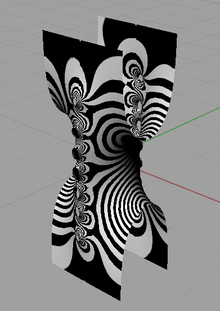Zebra striping (computer graphics)
3D diagnostic

Zebra striping is a diagnostic shading technique used in computer graphics to visualize curvature on smooth surfaces.[1] It is primarily used for computer aided design (CAD), where it helps checking that surfaces meet smoothly. It is a simulation of the visual effect of placing an object in a tunnel lit by parallel rows of lights, or a perfectly reflecting object in a room with striped walls. It has been implemented in a number of CAD products, including (but not limited to) Maya and Rhinoceros 3D.
It can be implemented as an environment map using radiating pie wedges as the source texture.
Table zebra striping
The term is also used for tables with every other row colored to make it easier to read tables. Although Zebra striping has been used for a long time to improve readability, there is relatively little data on how much it helps.[2][3]
CSS

Can be implemented using Cascading Style Sheets (CSS).
tr:nth-child(2n+1) {background-color: #efefef}
See also
- Green bar paper, continuous sheets pre-printed with green rows, once-common stationery used when physically printing tabular data
References
- ↑ Kenton Fleming, Computer Aided Engineering: An Undergraduate course in computer aided design and analysis for mechanical engineering technology, Southern Polytechnic State University. http://www.intellectbase.org/e_publications/jagr/JAGR_Volume_2_Issue_2.pdf
- ↑ Enders, Jessica: "Zebra Striping: Does it Really Help?", A List Apart, http://www.alistapart.com/articles/zebrastripingdoesithelp
- ↑ Enders, Jessica (September 9, 2008), "Zebra Striping: More Data for the Case", A List Apart